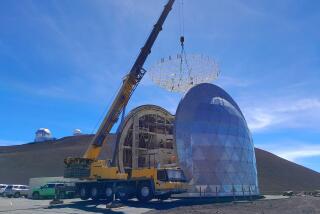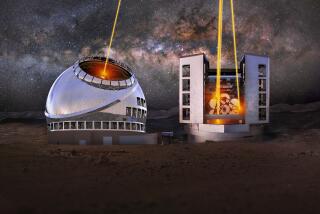Shooting for the Stars
- Share via
Growing up in a big city, a child could easily get the impression that the night sky is naturally pale purple, twinkling from the light of the urban grid and jumbo jets. Students who participate in the Telescopes in Education project know better.
Using computers in their classrooms, thousands of students around the world have access to a telescope on Mt. Wilson, high above the obscuring smog and lights of the Los Angeles Basin.
Students remotely control the 24-inch telescope once used to determine whether the moon’s surface would support manned landings. They take photographs of the universe for research or to enjoy as pretty pictures of celestial objects they could never see with a backyard telescope.
Viewpoint School in Calabasas is one of more than 200 schools nationwide participating in Telescopes in Education, or TIE, which is supported by NASA, the Jet Propulsion Laboratory in La Canada Flintridge and other organizations and businesses. The private school’s astronomy club met Friday for its monthly session with the telescope and a traditional dinner of Chinese food served with tongs from the chemistry lab.
Over a speakerphone, Dave Lavezzi, a volunteer at the observatory, told the 10 students that from his perch on the mountain, the night looked great for stargazing.
“There must be three or four galaxies that are shootable,” he said. TIE’s volunteers at Mt. Wilson--among them a science advisor to the TV show “Star Trek: The Next Generation,” several teachers and a clown--move the observatory’s dome and give students tips on manipulating the telescope from their computers. The coordinates of most celestial objects already are programmed into the TIE software, so a certain nebula or variable star can be pinpointed in a few keystrokes and mouse clicks.
Having completed their first school year in the TIE program, Viewpoint’s teenage astronomers have snapped many sharp photos of galaxies and other faraway objects. Next year they plan to use their discoveries for research projects, as other TIE schools have done. A few years ago, for example, students at Crossroads School in Santa Monica rediscovered a variable star that had not been charted since the 1950s.
“That’s the great thing about astronomy: Amateurs can assist [professionals] in a meaningful way,” said sophomore Joe Clark, president of Viewpoint’s astronomy club. He is using a 14-inch telescope on Mt. Wilson to study the rotations and speeds of such objects as asteroids.
Astronomy does not receive much attention in high schools’ science curricula, where biology, chemistry and physics tend to dominate. Beyond familiarizing students with the stellar world, programs such as TIE are designed to teach math and computer skills and the basics of photography.
Calculating the speed of a comet can seem more relevant to students than, say, figuring the speed of two trains bound for Kansas City, said Gil Clark, TIE’s director.
“This they can relate to, because every time they look up in the sky, they are reminded of what they did here,” said Clark, not related to the president of Viewpoint’s astronomy club. On Friday night, he taught them how to use their laptops to clean up overexposed photos taken by the telescope’s digital camera.
Entering its 10th year, TIE plans to make two more telescopes available beginning in September, in Chile and Australia. Their locations in the Southern Hemisphere will afford a broader view of the universe and open up more time slots for students, especially during daytime hours in the Northern Hemisphere, program director Clark said.






